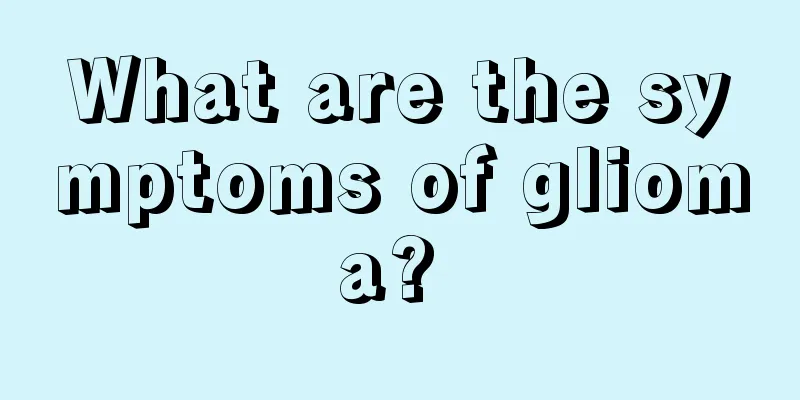What are the symptoms of glioma?

|
Glioma is medically known as glioma, which is a chronic disease. During the course of the disease, the symptoms will be aggravated due to bleeding and compression of the tumor and cystic lesions. Cystic tumors often occur in children and adolescent patients. At the beginning, it will cause decreased vision, dizziness, headache, abnormal nerve function, and severe problems with the limbs, causing epilepsy and finally paralysis. Therefore, treatment should start with understanding the condition. symptom Most brain gliomas develop slowly, with the time from the onset of symptoms to medical treatment generally taking weeks to months, and in some cases even years. The history of high-grade malignant tumors and posterior cranial fossa tumors is shorter, while the history of more benign tumors or tumors located in quiet areas is longer. If the tumor bleeds or becomes cystic, the symptoms may suddenly worsen and may even have a course similar to cerebrovascular disease. The clinical symptoms of glioma can be divided into two aspects. One is the symptoms of increased intracranial pressure, such as headache, vomiting, decreased vision, diplopia, mental symptoms, etc.; the other is the focal symptoms caused by tumor compression, infiltration, and destruction of brain tissue, which can manifest as irritation symptoms such as localized epilepsy in the early stage and neurological dysfunction symptoms such as paralysis in the later stage. Embryonic tumors of the central nervous system (CNS) include malignant germ cell tumors, medulloblastoma, primitive neuroectodermal tumor (PNET), etc., which are common in children and adolescents. Introduction to Brainstem Tumors (Brainstem Glioma): Brainstem tumors (brainstem gliomas) account for 1.4% of intracranial tumors. The main types of tumors are gliomas, among which astrocytomas and polar glioblastomas are more common, followed by oligodendrogliomas, ependymal gliomas, and medulloblastomas. In addition, hemangiomas (including angioreticulomas), cysts, teratomas, tuberculomas, metastatic tumors, etc. can also be seen. It is more common in children and adolescents, especially in children aged 5 to 9 years old. Children often have poorly differentiated polar glioblastomas, medulloblastomas, and ependymomas, while adults often have astrocytomas. The disease course in children is short and progresses rapidly; severe brainstem symptoms often occur within a short period of time (weeks to months); the disease course in adult patients is long and progresses slowly, and severe brainstem symptoms may not appear for several months or even more than a year. The distribution locations of various tumors in the brainstem are slightly different. Astrocytomas can be distributed in various parts of the brainstem, while medulloblastomas and ependymomas are distributed in the tegmentum of the aqueduct and the floor of the fourth ventricle. The symptoms of brainstem tumors (brainstem gliomas) can be divided into two categories: general symptoms and focal symptoms. The most common symptom is occipital headache. Children often have personality changes, and many patients have difficulty urinating. Increased intracranial pressure is not usually the first symptom of a brainstem tumor. Therefore, for progressive crossed palsy or multiple cranial nerve palsy combined with pyramidal tract damage, the possibility of a brainstem tumor should be considered first, regardless of the presence or absence of increased intracranial pressure. The focal symptoms of brainstem tumors vary with the location of the tumor. Due to the infiltrative growth of the tumor, it is actually difficult to clearly divide it into specific locations such as the midbrain or pons. 1) Midbrain tumors: Since the tumor can easily block the aqueduct, symptoms of increased intracranial pressure may appear in the early stages. There are also cases where the first symptoms are mental and intellectual changes, which may be related to the involvement of the reticular formation. Depending on the site of tumor invasion, common manifestations include: ① Crossed oculomotor nerve hemiplegia syndrome - Weber syndrome, the lesion is located at the base of the cerebral foot, with oculomotor nerve paralysis on the affected side and central paralysis of the upper and lower limbs and facial and tongue muscles on the opposite side. ②Quadrigeminal syndrome--Parrnaud syndrome, characterized by ptosis, upward gaze paralysis, fixed pupil, loss of light response, and inability to converge. ③Benedikt syndrome, manifested by deafness, oculomotor nerve paralysis on the affected side, increased muscle tone and tremor in the contralateral limbs, etc. 2) Pontine tumors: It accounts for more than half of all brainstem tumors and is more common in children. In early childhood, diplopia and easy falls are often the first symptoms; in adults, vertigo and ataxia are often the first symptoms. More than 90% of patients have symptoms of cranial nerve palsy, and about 40% of patients have abducens nerve palsy as the first symptom. As the tumor progresses, cranial nerve damage such as the facial nerve and trigeminal nerve and motor and sensory disorders of the limbs appear. It often presents with Millard-Gubler syndrome - hemilateral damage to the pons, including crossed facial nerve paralysis. If the lesion is located on one side of the lower half of the pons, it will cause peripheral facial paralysis on the affected side accompanied by hemiplegia of the contralateral limbs. |
<<: What causes pain in the spine when bending over?
>>: What is the process of minimally invasive heart valve repair surgery
Recommend
How to calculate the weight of a baby in the belly?
Nowadays, people pay more and more attention to e...
How much do you know about the 7 numbers that can keep you from shortening your life?
As our living standards continue to improve, heal...
5 tips to relieve foot bone hyperplasia
For people who often need to stand at work or run...
What are the side effects of cryotherapy
Cryotherapy is a new treatment method invented in...
Can I eat tofu after a burn? What is good to eat after a burn?
The wound after a burn needs careful care so that...
What should patients with colorectal cancer pay attention to in their daily lives
The cause of colorectal cancer is very complex an...
Adolescent's heart suddenly stabbed
Teenagers are generally healthier both physically...
Tension headache symptoms and treatment
Tension headache, also known as muscle contractio...
How to prevent and treat thyroid cancer in children?
The harm caused by thyroid cancer is relatively l...
Authentic recipe for stir-fried eggplant with soy sauce
Stir-fried eggplant with soybean sauce is a commo...
What should you pay attention to in your diet to prevent liver cancer? To prevent liver cancer, try eating more of these foods
Scientific research has found that drinking too m...
Which hospital is best for treating brain cancer
Brain cancer refers to a new growth in the crania...
Benefits of squat exercise
Squats are a compound exercise that trains the lo...
My throat is very dry and feels like there is something foreign in it
The throat is a relatively important part of our ...
The harm of quitting smoking and relapse
Although smoking is harmful to health, there are ...









